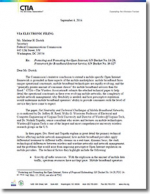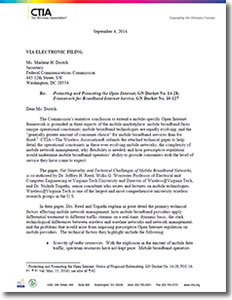Net Neutrality and Technical Challenges of Mobile Broadband Networks
This paper explains that mobile broadband inextricably intertwines transmission and processing capabilities, and thus remains an “integrated information service.”
Dear Ms. Dortch:
The Commission’s tentative conclusion to extend a mobile-specific Open Internet framework is grounded in three aspects of the mobile marketplace: mobile broadband faces unique operational constraints; mobile broadband technologies are rapidly evolving; and the “generally greater amount of consumer choice” for mobile broadband services than for fixed.
CTIA - The Wireless Association® submits the attached technical paper to help detail the operational constraints in these ever-evolving mobile networks, the complexity of mobile network management, why flexibility is needed, and how prescriptive regulation would undermine mobile broadband operators’ ability to provide consumers with the level of service they have come to expect.
The paper, Net Neutrality and Technical Challenges of Mobile Broadband Networks, is co-authored by Dr. Jeffrey H. Reed, Willis G. Worcester Professor of Electrical and Computer Engineering at Virginia Tech University and Director of Wireless@Virginia Tech, and Dr. Nishith Tripathi, senior consultant who writes and lectures on mobile technologies. Wireless@Virginia Tech is one of the largest and most comprehensive university wireless research groups in the U.S.
In their paper, Drs. Reed and Tripathi explain in great detail the primary technical factors affecting mobile network management; how mobile broadband providers apply differential treatment to different traffic streams on a real-time, dynamic basis; the stark technological differences between wireless and wireline networks and network management; and the problems that would arise from imposing prescriptive Open Internet regulation on mobile providers. The technical factors they highlight include the following:
- Scarcity of radio resources. With the explosion in the amount of mobile data traffic, spectrum resources have not kept pace. Mobile broadband operators limited radio resources.
- Radio resource sharing. As the number of users being served by the same base station fluctuates, the challenge of providing high-quality service to each of them also grows, requiring providers to make choices regarding how to manage network resources.
- Dynamic channel conditions. The allocation of radio resources constantly changes due to changing channel conditions and the interference environment, as often as every millisecond.
- Varying resource consumption. For a given channel condition, different services consume different amounts of resources. Thus, resource allocations change as users shift among different uses – often many times during a given session.
- Integration of devices and the network. Even when two devices experience identical channel conditions and allocation of radio resources, their design characteristics may dictate widely different throughput, further complicating network management.
- Ever-evolving network. Mobile broadband providers constantly manage user mobility across various technology generations and revisions across the network, offering differing levels of achievable network performance.
- Challenges of network capacity additions. The intricacies of capacity growth (adding spectrum and wireless infrastructure deployment), along with ever-rising user traffic, make efficient utilization of the existing radio resources extremely critical to the user experience and network efficiency.
Drs. Reed and Tripathi also explain that mobile and fixed networks face vastly different technical challenges. Fixed networks have significantly higher capacity and predictability of resource requirements, whereas mobile networks are far more capacity constrained, with constantly changing user requirements and operating environments. Fixed networks involve channels that are relatively clean with signal regeneration, while mobile channels are impaired with interference, multipath and blockage, varying by location and from one millisecond to the next. As they observe, “The wireline network engineer knows precisely how much bandwidth is available in a single fiber optic strand and (other than losses over distance) will have a near-constant understanding of the performance of the transport layer. In contrast, wireless networks are faced with ever-changing radio environments.”
Mobile broadband providers need more flexibility to manage their networks and to ensure that their customers have the service they have come to expect. As the paper explains, that flexibility must include the ability to manage applications to avoid harm to the network and to maintain reliable and efficient service for the aggregate user experience. Similarly, mobile operators should be free from any anti-discrimination or commercial reasonableness requirement that would restrict their ability to innovate, optimize, and differentiate service to deliver a high quality product. In addition, expanded transparency requirements are infeasible in the context of dynamic, ever-changing mobile network operations. As Drs. Reed and Tripathi conclude, more prescriptive mobile rules “would stifle innovation and competition, negatively impact the user-experience and system capacity, and severely limit the ability of mobile wireless networks to meet the unique challenges faced by modern wireless networks.”
The paper paints a detailed picture of the difficulties that would be created by the application of an overly broad or overly prescriptive set of rules on mobile broadband. As Reed and Tripathi explain, “subjecting this type of network and network management to broad prophylactic rules with a vague ‘exception’ standard would provide no clarity to carriers, edge providers, or consumers as to how these networks will be managed. The exception would either simply subsume any rules (e.g., blocking or non-discrimination) or providers would be stripped of their ability to evolve and manage networks for the betterment of the entire subscriber base.”
The paper also explains that mobile broadband inextricably intertwines transmission and processing capabilities, and thus remains an “integrated information service.” Mobile broadband service involves extensive and complex processing throughout the network to ensure that customers can seamlessly navigate among multiple applications and services, and different network nodes must constantly engage in service-specific processing to support the user’s activities. As Drs. Reed and Tripathi show, this tight integration between transmission and processing is essential whether the user is browsing a website, engaged in mobile video conferencing, or undertaking any of the myriad other activities made possible by mobile broadband. This factual finding further confirms the FCC’s prior determinations in 2007 and 2010 that mobile broadband Internet access is an integrated information service that must remain subject to a Title I framework. Moreover, the engineering and operational complexities outlined in this report make a Title II common carrier regulatory approach even more problematic.
We look forward to exploring these principles further as the Commission considers how best to promote mobile broadband and the interests of the American consumer.
Sincerely,
/s/ Scott Bergmann
Scott Bergmann
Vice President – Regulatory Affairs
CTIA – The Wireless Association®
What’s Related


Favorites





